Evidence-Based Practice: Oncology Nurses' Chemotherapy Safe Handling
VerifiedAdded on 2023/06/04
|11
|2656
|246
Literature Review
AI Summary
This paper critically evaluates a research article focusing on oncology nurses' adherence to safe-handling practices during chemotherapy administration, highlighting the risk of occupational exposure to hazardous drugs. The review examines the research question, sample, study design, data collection methods, and findings of the study, which used a mixed-method approach to compare objective observation data with subjective self-assessment data. The findings revealed gaps in adherence to PPE and safe handling practices, indicating a need for improved safety measures and organizational support. Despite limitations such as small sample size and single-center study design, the research underscores the importance of addressing occupational risks for oncology nurses and implementing strategies to reduce exposure to hazardous agents.
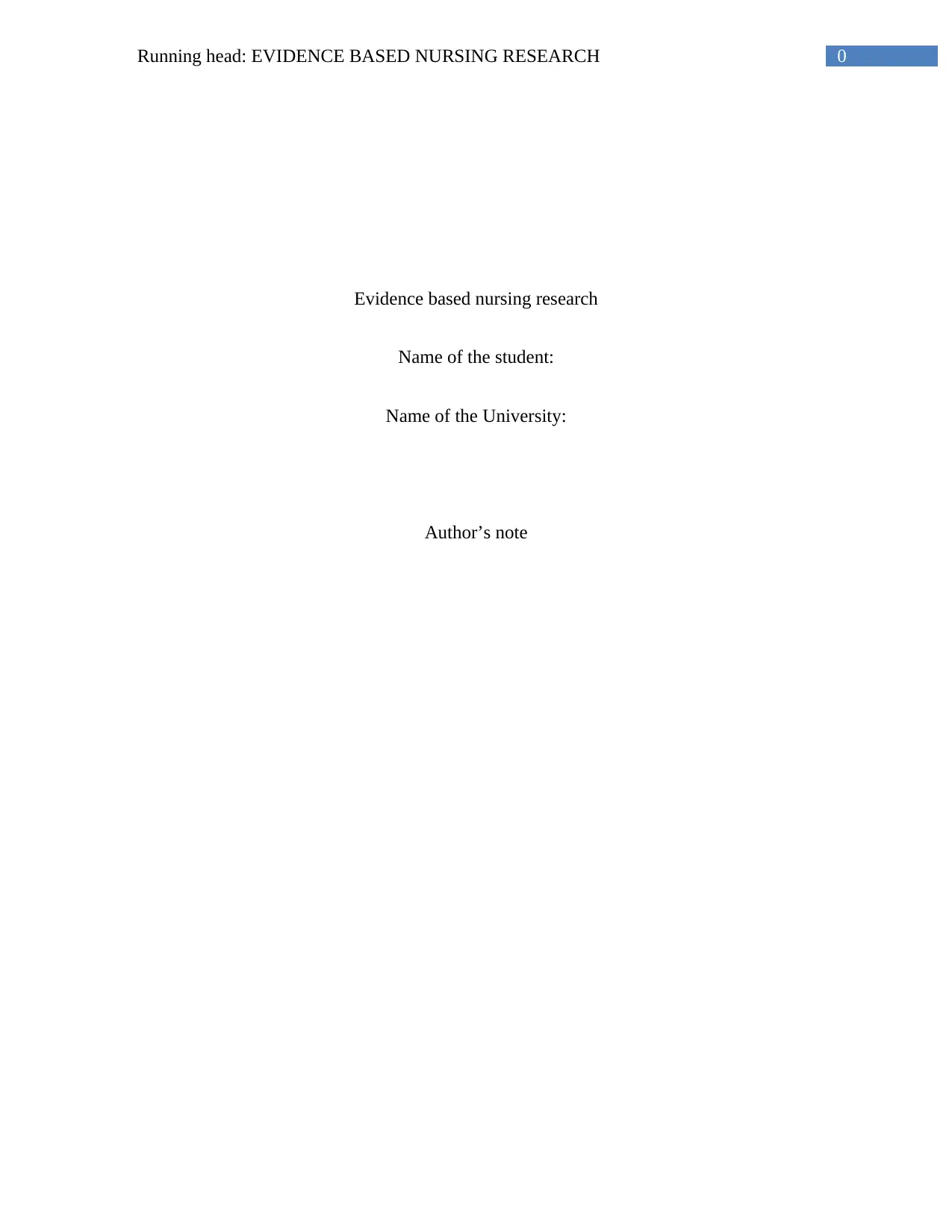
0Running head: EVIDENCE BASED NURSING RESEARCH
Evidence based nursing research
Name of the student:
Name of the University:
Author’s note
Evidence based nursing research
Name of the student:
Name of the University:
Author’s note
Paraphrase This Document
Need a fresh take? Get an instant paraphrase of this document with our AI Paraphraser
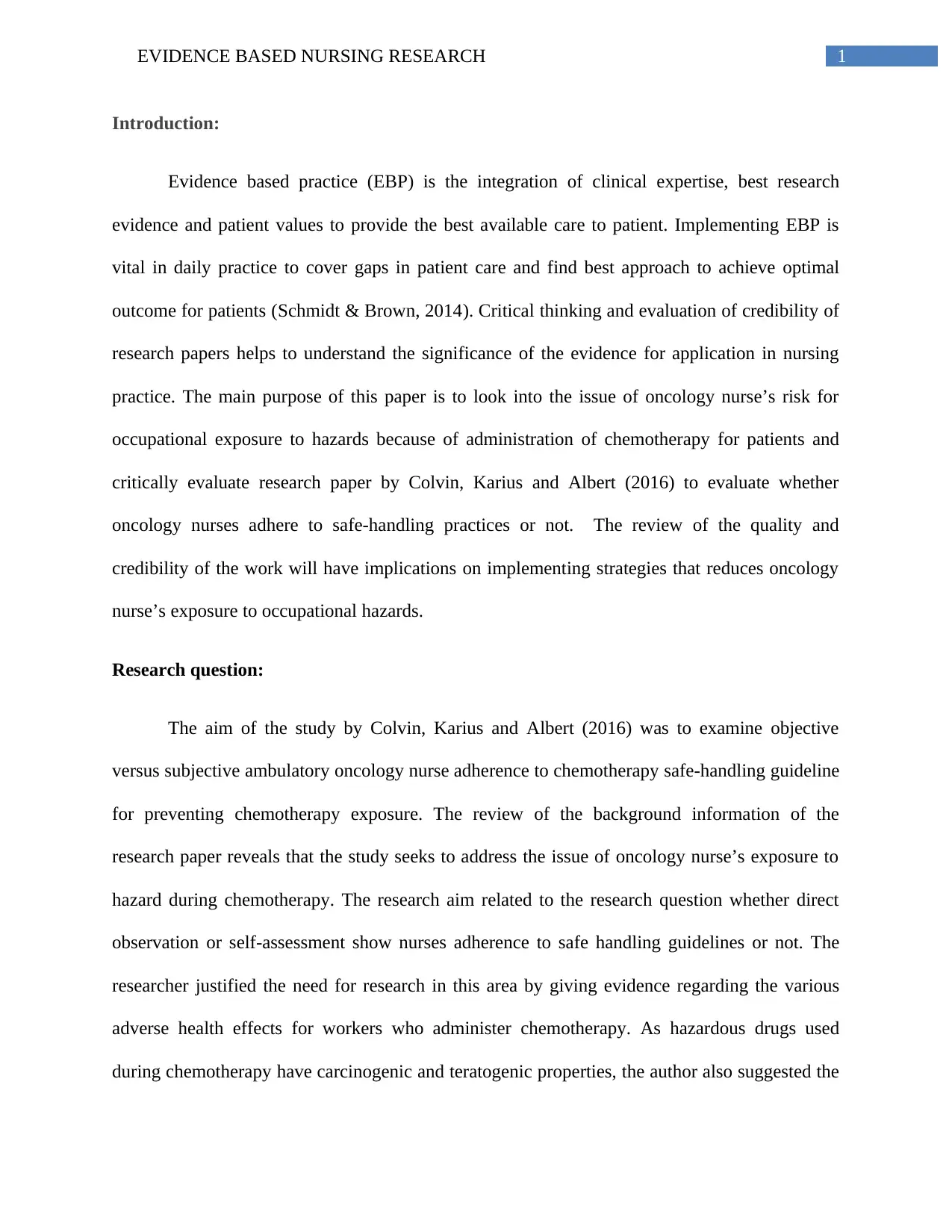
1EVIDENCE BASED NURSING RESEARCH
Introduction:
Evidence based practice (EBP) is the integration of clinical expertise, best research
evidence and patient values to provide the best available care to patient. Implementing EBP is
vital in daily practice to cover gaps in patient care and find best approach to achieve optimal
outcome for patients (Schmidt & Brown, 2014). Critical thinking and evaluation of credibility of
research papers helps to understand the significance of the evidence for application in nursing
practice. The main purpose of this paper is to look into the issue of oncology nurse’s risk for
occupational exposure to hazards because of administration of chemotherapy for patients and
critically evaluate research paper by Colvin, Karius and Albert (2016) to evaluate whether
oncology nurses adhere to safe-handling practices or not. The review of the quality and
credibility of the work will have implications on implementing strategies that reduces oncology
nurse’s exposure to occupational hazards.
Research question:
The aim of the study by Colvin, Karius and Albert (2016) was to examine objective
versus subjective ambulatory oncology nurse adherence to chemotherapy safe-handling guideline
for preventing chemotherapy exposure. The review of the background information of the
research paper reveals that the study seeks to address the issue of oncology nurse’s exposure to
hazard during chemotherapy. The research aim related to the research question whether direct
observation or self-assessment show nurses adherence to safe handling guidelines or not. The
researcher justified the need for research in this area by giving evidence regarding the various
adverse health effects for workers who administer chemotherapy. As hazardous drugs used
during chemotherapy have carcinogenic and teratogenic properties, the author also suggested the
Introduction:
Evidence based practice (EBP) is the integration of clinical expertise, best research
evidence and patient values to provide the best available care to patient. Implementing EBP is
vital in daily practice to cover gaps in patient care and find best approach to achieve optimal
outcome for patients (Schmidt & Brown, 2014). Critical thinking and evaluation of credibility of
research papers helps to understand the significance of the evidence for application in nursing
practice. The main purpose of this paper is to look into the issue of oncology nurse’s risk for
occupational exposure to hazards because of administration of chemotherapy for patients and
critically evaluate research paper by Colvin, Karius and Albert (2016) to evaluate whether
oncology nurses adhere to safe-handling practices or not. The review of the quality and
credibility of the work will have implications on implementing strategies that reduces oncology
nurse’s exposure to occupational hazards.
Research question:
The aim of the study by Colvin, Karius and Albert (2016) was to examine objective
versus subjective ambulatory oncology nurse adherence to chemotherapy safe-handling guideline
for preventing chemotherapy exposure. The review of the background information of the
research paper reveals that the study seeks to address the issue of oncology nurse’s exposure to
hazard during chemotherapy. The research aim related to the research question whether direct
observation or self-assessment show nurses adherence to safe handling guidelines or not. The
researcher justified the need for research in this area by giving evidence regarding the various
adverse health effects for workers who administer chemotherapy. As hazardous drugs used
during chemotherapy have carcinogenic and teratogenic properties, the author also suggested the
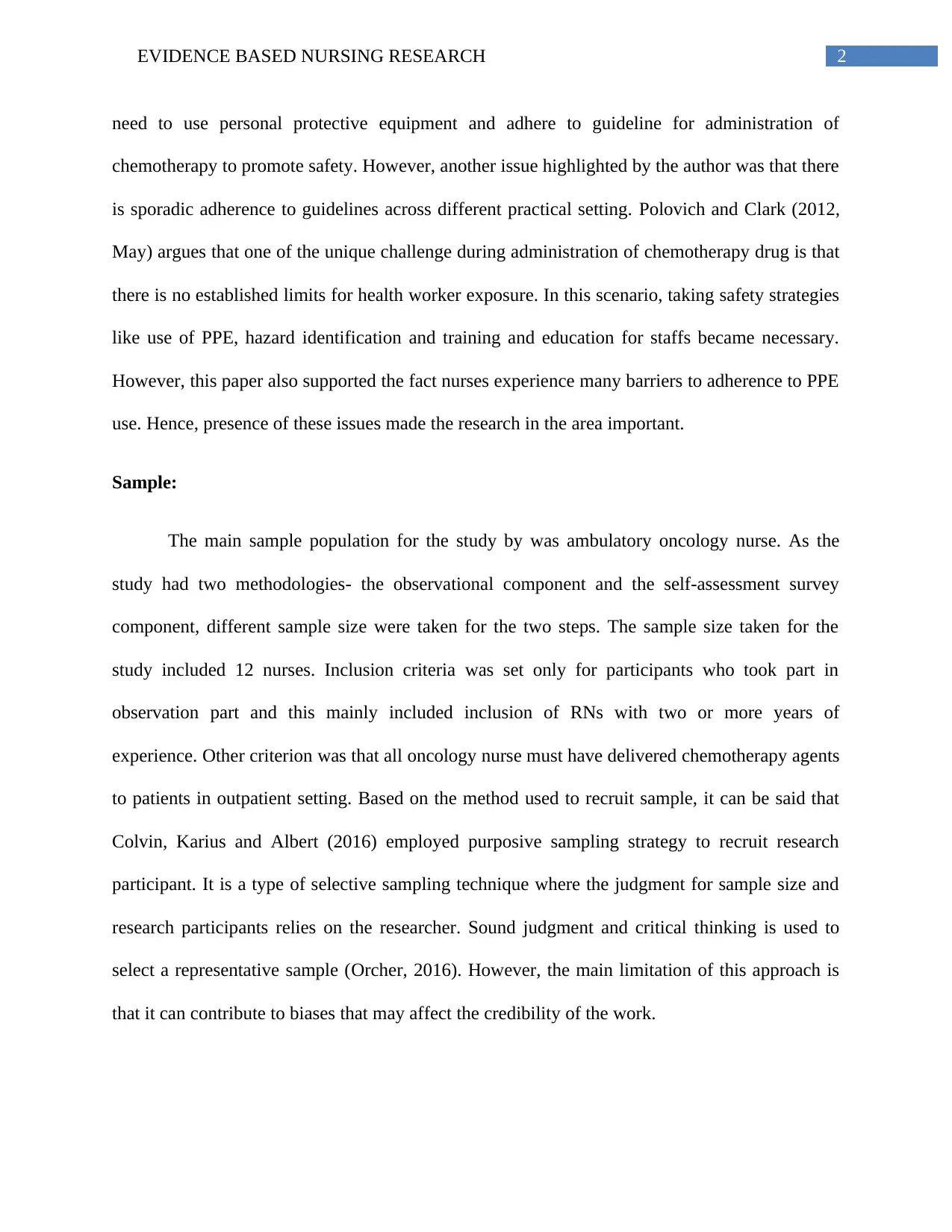
2EVIDENCE BASED NURSING RESEARCH
need to use personal protective equipment and adhere to guideline for administration of
chemotherapy to promote safety. However, another issue highlighted by the author was that there
is sporadic adherence to guidelines across different practical setting. Polovich and Clark (2012,
May) argues that one of the unique challenge during administration of chemotherapy drug is that
there is no established limits for health worker exposure. In this scenario, taking safety strategies
like use of PPE, hazard identification and training and education for staffs became necessary.
However, this paper also supported the fact nurses experience many barriers to adherence to PPE
use. Hence, presence of these issues made the research in the area important.
Sample:
The main sample population for the study by was ambulatory oncology nurse. As the
study had two methodologies- the observational component and the self-assessment survey
component, different sample size were taken for the two steps. The sample size taken for the
study included 12 nurses. Inclusion criteria was set only for participants who took part in
observation part and this mainly included inclusion of RNs with two or more years of
experience. Other criterion was that all oncology nurse must have delivered chemotherapy agents
to patients in outpatient setting. Based on the method used to recruit sample, it can be said that
Colvin, Karius and Albert (2016) employed purposive sampling strategy to recruit research
participant. It is a type of selective sampling technique where the judgment for sample size and
research participants relies on the researcher. Sound judgment and critical thinking is used to
select a representative sample (Orcher, 2016). However, the main limitation of this approach is
that it can contribute to biases that may affect the credibility of the work.
need to use personal protective equipment and adhere to guideline for administration of
chemotherapy to promote safety. However, another issue highlighted by the author was that there
is sporadic adherence to guidelines across different practical setting. Polovich and Clark (2012,
May) argues that one of the unique challenge during administration of chemotherapy drug is that
there is no established limits for health worker exposure. In this scenario, taking safety strategies
like use of PPE, hazard identification and training and education for staffs became necessary.
However, this paper also supported the fact nurses experience many barriers to adherence to PPE
use. Hence, presence of these issues made the research in the area important.
Sample:
The main sample population for the study by was ambulatory oncology nurse. As the
study had two methodologies- the observational component and the self-assessment survey
component, different sample size were taken for the two steps. The sample size taken for the
study included 12 nurses. Inclusion criteria was set only for participants who took part in
observation part and this mainly included inclusion of RNs with two or more years of
experience. Other criterion was that all oncology nurse must have delivered chemotherapy agents
to patients in outpatient setting. Based on the method used to recruit sample, it can be said that
Colvin, Karius and Albert (2016) employed purposive sampling strategy to recruit research
participant. It is a type of selective sampling technique where the judgment for sample size and
research participants relies on the researcher. Sound judgment and critical thinking is used to
select a representative sample (Orcher, 2016). However, the main limitation of this approach is
that it can contribute to biases that may affect the credibility of the work.
⊘ This is a preview!⊘
Do you want full access?
Subscribe today to unlock all pages.

Trusted by 1+ million students worldwide
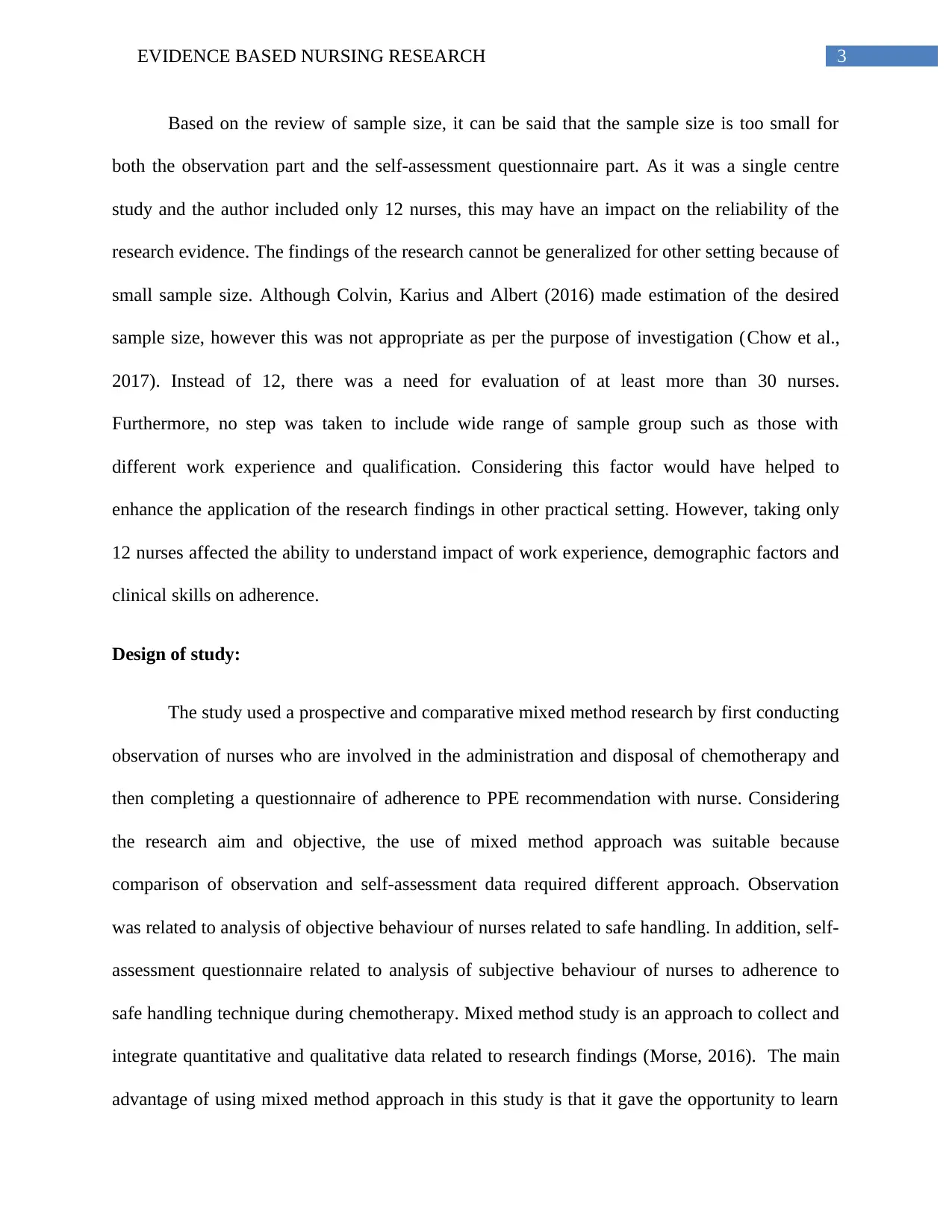
3EVIDENCE BASED NURSING RESEARCH
Based on the review of sample size, it can be said that the sample size is too small for
both the observation part and the self-assessment questionnaire part. As it was a single centre
study and the author included only 12 nurses, this may have an impact on the reliability of the
research evidence. The findings of the research cannot be generalized for other setting because of
small sample size. Although Colvin, Karius and Albert (2016) made estimation of the desired
sample size, however this was not appropriate as per the purpose of investigation (Chow et al.,
2017). Instead of 12, there was a need for evaluation of at least more than 30 nurses.
Furthermore, no step was taken to include wide range of sample group such as those with
different work experience and qualification. Considering this factor would have helped to
enhance the application of the research findings in other practical setting. However, taking only
12 nurses affected the ability to understand impact of work experience, demographic factors and
clinical skills on adherence.
Design of study:
The study used a prospective and comparative mixed method research by first conducting
observation of nurses who are involved in the administration and disposal of chemotherapy and
then completing a questionnaire of adherence to PPE recommendation with nurse. Considering
the research aim and objective, the use of mixed method approach was suitable because
comparison of observation and self-assessment data required different approach. Observation
was related to analysis of objective behaviour of nurses related to safe handling. In addition, self-
assessment questionnaire related to analysis of subjective behaviour of nurses to adherence to
safe handling technique during chemotherapy. Mixed method study is an approach to collect and
integrate quantitative and qualitative data related to research findings (Morse, 2016). The main
advantage of using mixed method approach in this study is that it gave the opportunity to learn
Based on the review of sample size, it can be said that the sample size is too small for
both the observation part and the self-assessment questionnaire part. As it was a single centre
study and the author included only 12 nurses, this may have an impact on the reliability of the
research evidence. The findings of the research cannot be generalized for other setting because of
small sample size. Although Colvin, Karius and Albert (2016) made estimation of the desired
sample size, however this was not appropriate as per the purpose of investigation (Chow et al.,
2017). Instead of 12, there was a need for evaluation of at least more than 30 nurses.
Furthermore, no step was taken to include wide range of sample group such as those with
different work experience and qualification. Considering this factor would have helped to
enhance the application of the research findings in other practical setting. However, taking only
12 nurses affected the ability to understand impact of work experience, demographic factors and
clinical skills on adherence.
Design of study:
The study used a prospective and comparative mixed method research by first conducting
observation of nurses who are involved in the administration and disposal of chemotherapy and
then completing a questionnaire of adherence to PPE recommendation with nurse. Considering
the research aim and objective, the use of mixed method approach was suitable because
comparison of observation and self-assessment data required different approach. Observation
was related to analysis of objective behaviour of nurses related to safe handling. In addition, self-
assessment questionnaire related to analysis of subjective behaviour of nurses to adherence to
safe handling technique during chemotherapy. Mixed method study is an approach to collect and
integrate quantitative and qualitative data related to research findings (Morse, 2016). The main
advantage of using mixed method approach in this study is that it gave the opportunity to learn
Paraphrase This Document
Need a fresh take? Get an instant paraphrase of this document with our AI Paraphraser
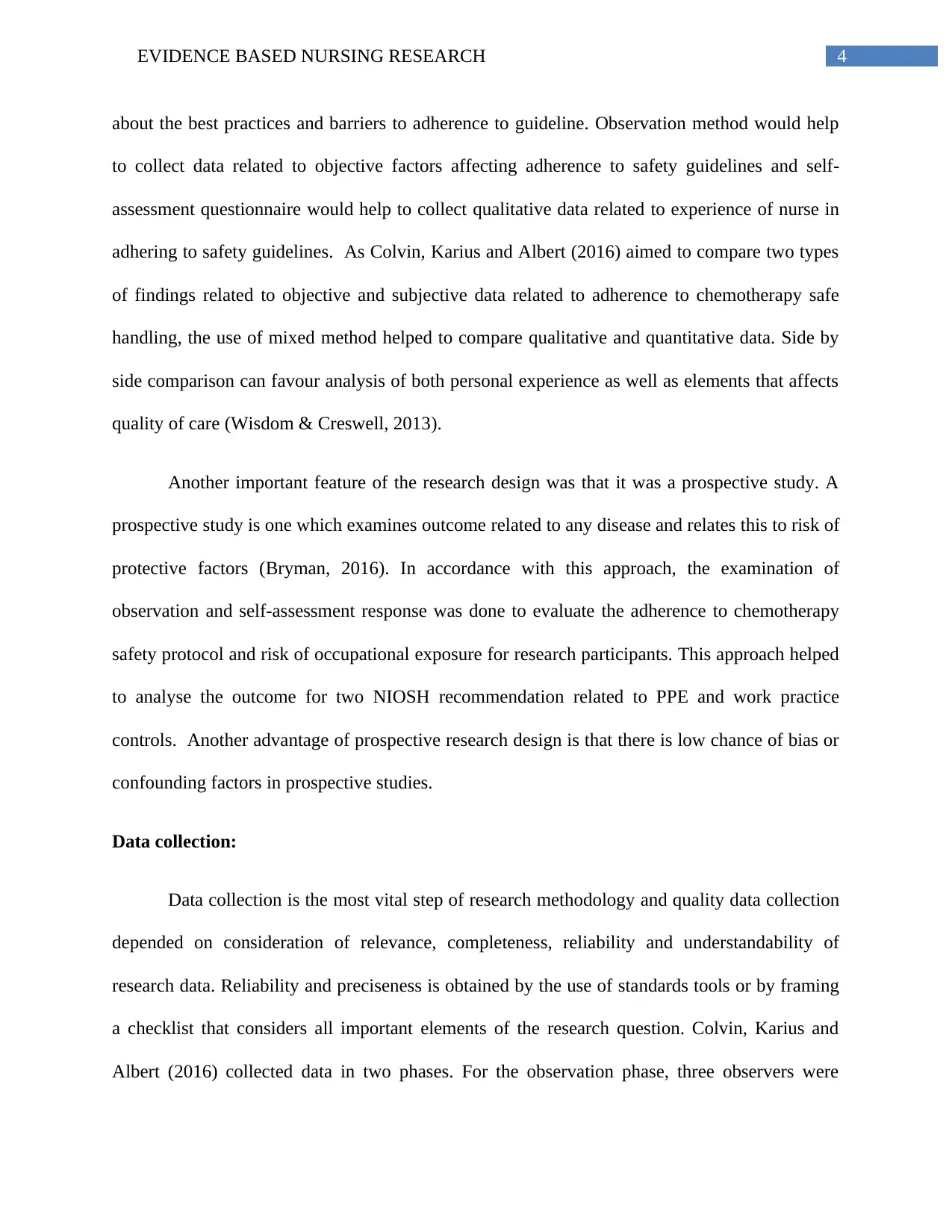
4EVIDENCE BASED NURSING RESEARCH
about the best practices and barriers to adherence to guideline. Observation method would help
to collect data related to objective factors affecting adherence to safety guidelines and self-
assessment questionnaire would help to collect qualitative data related to experience of nurse in
adhering to safety guidelines. As Colvin, Karius and Albert (2016) aimed to compare two types
of findings related to objective and subjective data related to adherence to chemotherapy safe
handling, the use of mixed method helped to compare qualitative and quantitative data. Side by
side comparison can favour analysis of both personal experience as well as elements that affects
quality of care (Wisdom & Creswell, 2013).
Another important feature of the research design was that it was a prospective study. A
prospective study is one which examines outcome related to any disease and relates this to risk of
protective factors (Bryman, 2016). In accordance with this approach, the examination of
observation and self-assessment response was done to evaluate the adherence to chemotherapy
safety protocol and risk of occupational exposure for research participants. This approach helped
to analyse the outcome for two NIOSH recommendation related to PPE and work practice
controls. Another advantage of prospective research design is that there is low chance of bias or
confounding factors in prospective studies.
Data collection:
Data collection is the most vital step of research methodology and quality data collection
depended on consideration of relevance, completeness, reliability and understandability of
research data. Reliability and preciseness is obtained by the use of standards tools or by framing
a checklist that considers all important elements of the research question. Colvin, Karius and
Albert (2016) collected data in two phases. For the observation phase, three observers were
about the best practices and barriers to adherence to guideline. Observation method would help
to collect data related to objective factors affecting adherence to safety guidelines and self-
assessment questionnaire would help to collect qualitative data related to experience of nurse in
adhering to safety guidelines. As Colvin, Karius and Albert (2016) aimed to compare two types
of findings related to objective and subjective data related to adherence to chemotherapy safe
handling, the use of mixed method helped to compare qualitative and quantitative data. Side by
side comparison can favour analysis of both personal experience as well as elements that affects
quality of care (Wisdom & Creswell, 2013).
Another important feature of the research design was that it was a prospective study. A
prospective study is one which examines outcome related to any disease and relates this to risk of
protective factors (Bryman, 2016). In accordance with this approach, the examination of
observation and self-assessment response was done to evaluate the adherence to chemotherapy
safety protocol and risk of occupational exposure for research participants. This approach helped
to analyse the outcome for two NIOSH recommendation related to PPE and work practice
controls. Another advantage of prospective research design is that there is low chance of bias or
confounding factors in prospective studies.
Data collection:
Data collection is the most vital step of research methodology and quality data collection
depended on consideration of relevance, completeness, reliability and understandability of
research data. Reliability and preciseness is obtained by the use of standards tools or by framing
a checklist that considers all important elements of the research question. Colvin, Karius and
Albert (2016) collected data in two phases. For the observation phase, three observers were
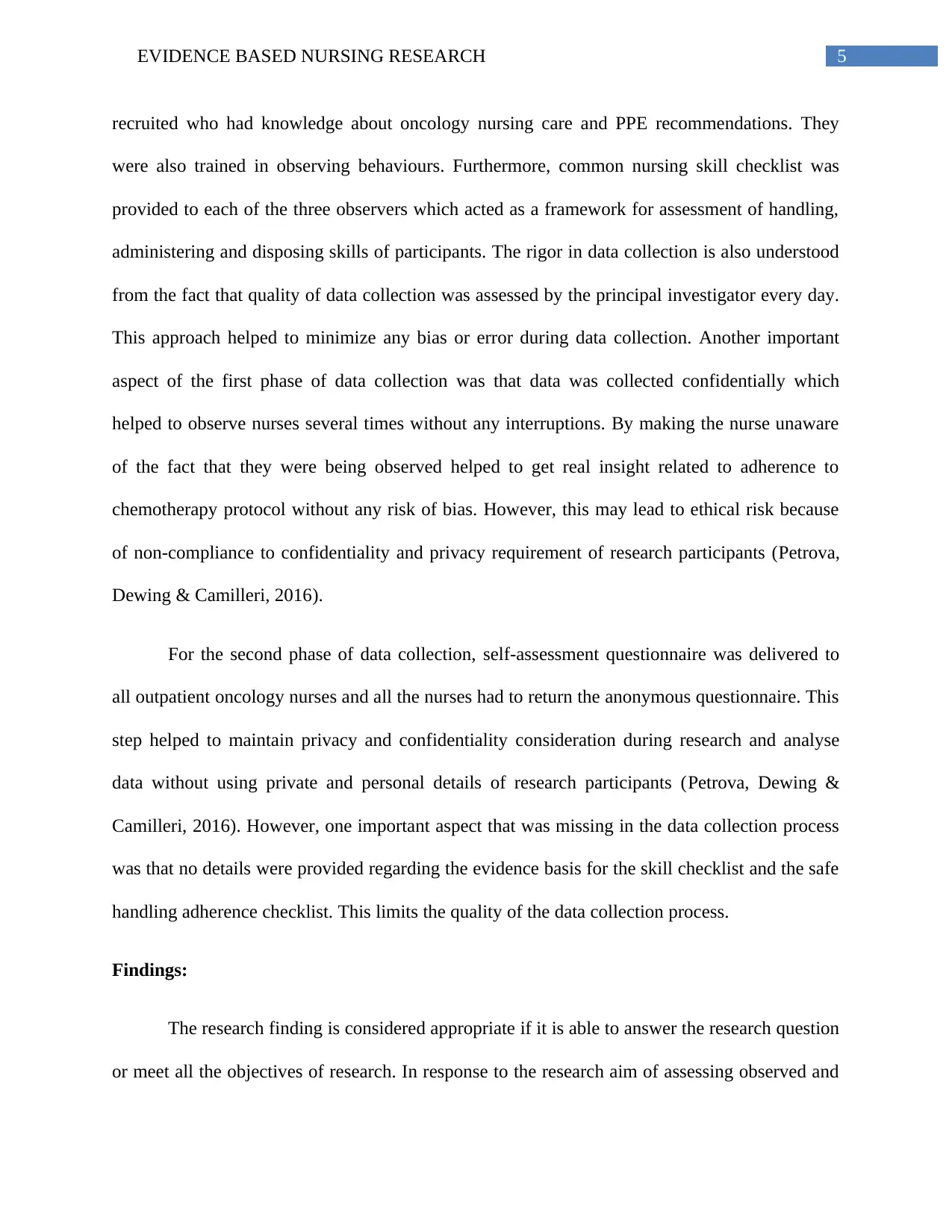
5EVIDENCE BASED NURSING RESEARCH
recruited who had knowledge about oncology nursing care and PPE recommendations. They
were also trained in observing behaviours. Furthermore, common nursing skill checklist was
provided to each of the three observers which acted as a framework for assessment of handling,
administering and disposing skills of participants. The rigor in data collection is also understood
from the fact that quality of data collection was assessed by the principal investigator every day.
This approach helped to minimize any bias or error during data collection. Another important
aspect of the first phase of data collection was that data was collected confidentially which
helped to observe nurses several times without any interruptions. By making the nurse unaware
of the fact that they were being observed helped to get real insight related to adherence to
chemotherapy protocol without any risk of bias. However, this may lead to ethical risk because
of non-compliance to confidentiality and privacy requirement of research participants (Petrova,
Dewing & Camilleri, 2016).
For the second phase of data collection, self-assessment questionnaire was delivered to
all outpatient oncology nurses and all the nurses had to return the anonymous questionnaire. This
step helped to maintain privacy and confidentiality consideration during research and analyse
data without using private and personal details of research participants (Petrova, Dewing &
Camilleri, 2016). However, one important aspect that was missing in the data collection process
was that no details were provided regarding the evidence basis for the skill checklist and the safe
handling adherence checklist. This limits the quality of the data collection process.
Findings:
The research finding is considered appropriate if it is able to answer the research question
or meet all the objectives of research. In response to the research aim of assessing observed and
recruited who had knowledge about oncology nursing care and PPE recommendations. They
were also trained in observing behaviours. Furthermore, common nursing skill checklist was
provided to each of the three observers which acted as a framework for assessment of handling,
administering and disposing skills of participants. The rigor in data collection is also understood
from the fact that quality of data collection was assessed by the principal investigator every day.
This approach helped to minimize any bias or error during data collection. Another important
aspect of the first phase of data collection was that data was collected confidentially which
helped to observe nurses several times without any interruptions. By making the nurse unaware
of the fact that they were being observed helped to get real insight related to adherence to
chemotherapy protocol without any risk of bias. However, this may lead to ethical risk because
of non-compliance to confidentiality and privacy requirement of research participants (Petrova,
Dewing & Camilleri, 2016).
For the second phase of data collection, self-assessment questionnaire was delivered to
all outpatient oncology nurses and all the nurses had to return the anonymous questionnaire. This
step helped to maintain privacy and confidentiality consideration during research and analyse
data without using private and personal details of research participants (Petrova, Dewing &
Camilleri, 2016). However, one important aspect that was missing in the data collection process
was that no details were provided regarding the evidence basis for the skill checklist and the safe
handling adherence checklist. This limits the quality of the data collection process.
Findings:
The research finding is considered appropriate if it is able to answer the research question
or meet all the objectives of research. In response to the research aim of assessing observed and
⊘ This is a preview!⊘
Do you want full access?
Subscribe today to unlock all pages.

Trusted by 1+ million students worldwide
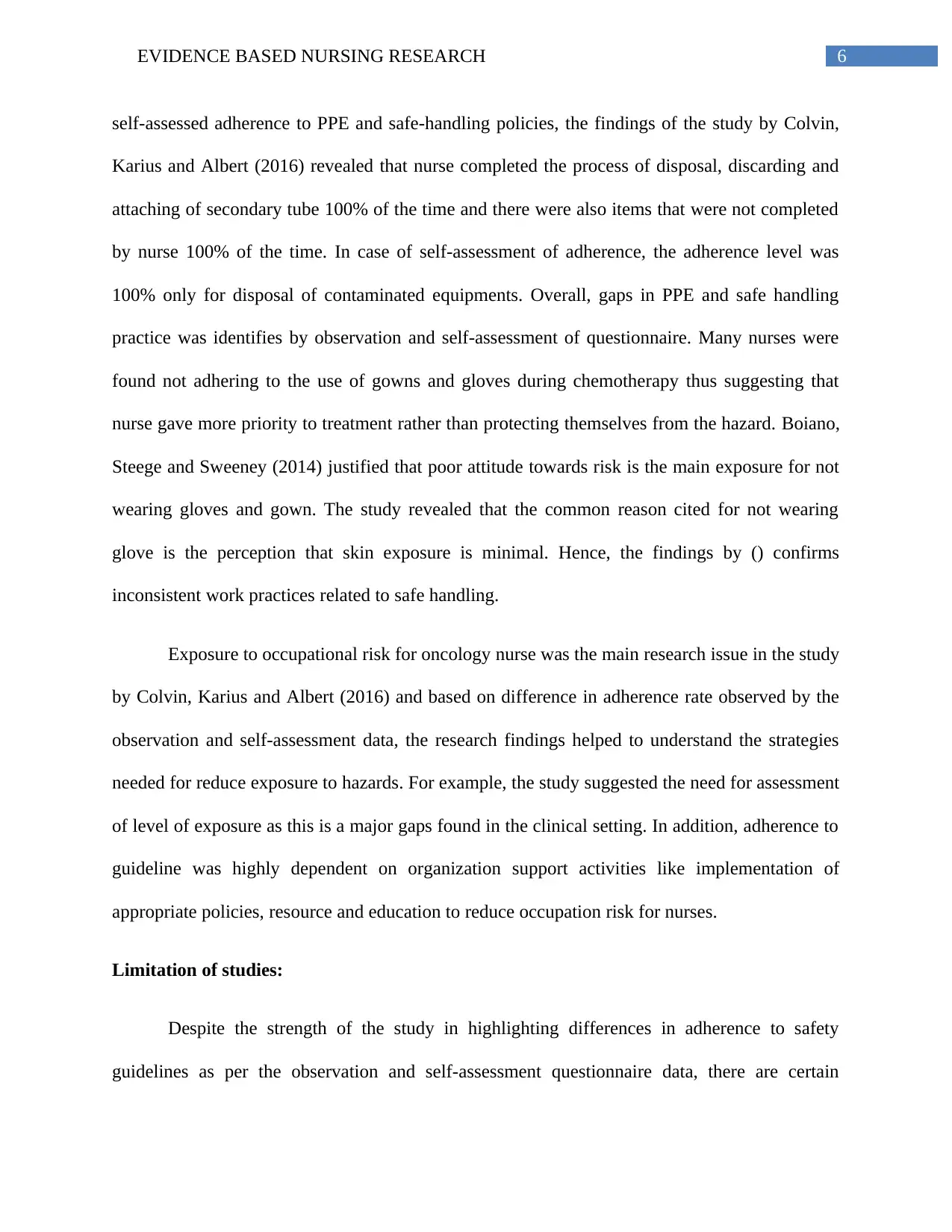
6EVIDENCE BASED NURSING RESEARCH
self-assessed adherence to PPE and safe-handling policies, the findings of the study by Colvin,
Karius and Albert (2016) revealed that nurse completed the process of disposal, discarding and
attaching of secondary tube 100% of the time and there were also items that were not completed
by nurse 100% of the time. In case of self-assessment of adherence, the adherence level was
100% only for disposal of contaminated equipments. Overall, gaps in PPE and safe handling
practice was identifies by observation and self-assessment of questionnaire. Many nurses were
found not adhering to the use of gowns and gloves during chemotherapy thus suggesting that
nurse gave more priority to treatment rather than protecting themselves from the hazard. Boiano,
Steege and Sweeney (2014) justified that poor attitude towards risk is the main exposure for not
wearing gloves and gown. The study revealed that the common reason cited for not wearing
glove is the perception that skin exposure is minimal. Hence, the findings by () confirms
inconsistent work practices related to safe handling.
Exposure to occupational risk for oncology nurse was the main research issue in the study
by Colvin, Karius and Albert (2016) and based on difference in adherence rate observed by the
observation and self-assessment data, the research findings helped to understand the strategies
needed for reduce exposure to hazards. For example, the study suggested the need for assessment
of level of exposure as this is a major gaps found in the clinical setting. In addition, adherence to
guideline was highly dependent on organization support activities like implementation of
appropriate policies, resource and education to reduce occupation risk for nurses.
Limitation of studies:
Despite the strength of the study in highlighting differences in adherence to safety
guidelines as per the observation and self-assessment questionnaire data, there are certain
self-assessed adherence to PPE and safe-handling policies, the findings of the study by Colvin,
Karius and Albert (2016) revealed that nurse completed the process of disposal, discarding and
attaching of secondary tube 100% of the time and there were also items that were not completed
by nurse 100% of the time. In case of self-assessment of adherence, the adherence level was
100% only for disposal of contaminated equipments. Overall, gaps in PPE and safe handling
practice was identifies by observation and self-assessment of questionnaire. Many nurses were
found not adhering to the use of gowns and gloves during chemotherapy thus suggesting that
nurse gave more priority to treatment rather than protecting themselves from the hazard. Boiano,
Steege and Sweeney (2014) justified that poor attitude towards risk is the main exposure for not
wearing gloves and gown. The study revealed that the common reason cited for not wearing
glove is the perception that skin exposure is minimal. Hence, the findings by () confirms
inconsistent work practices related to safe handling.
Exposure to occupational risk for oncology nurse was the main research issue in the study
by Colvin, Karius and Albert (2016) and based on difference in adherence rate observed by the
observation and self-assessment data, the research findings helped to understand the strategies
needed for reduce exposure to hazards. For example, the study suggested the need for assessment
of level of exposure as this is a major gaps found in the clinical setting. In addition, adherence to
guideline was highly dependent on organization support activities like implementation of
appropriate policies, resource and education to reduce occupation risk for nurses.
Limitation of studies:
Despite the strength of the study in highlighting differences in adherence to safety
guidelines as per the observation and self-assessment questionnaire data, there are certain
Paraphrase This Document
Need a fresh take? Get an instant paraphrase of this document with our AI Paraphraser
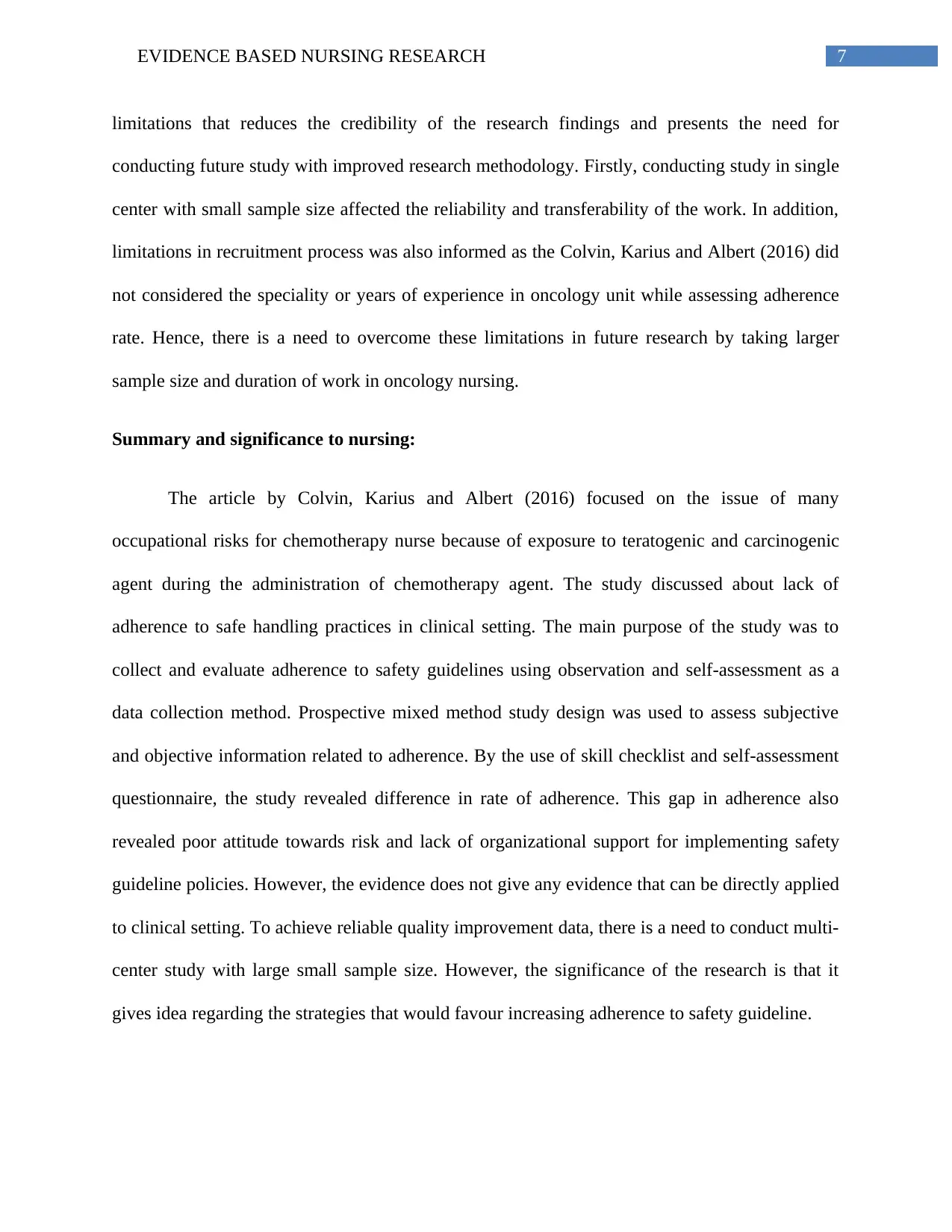
7EVIDENCE BASED NURSING RESEARCH
limitations that reduces the credibility of the research findings and presents the need for
conducting future study with improved research methodology. Firstly, conducting study in single
center with small sample size affected the reliability and transferability of the work. In addition,
limitations in recruitment process was also informed as the Colvin, Karius and Albert (2016) did
not considered the speciality or years of experience in oncology unit while assessing adherence
rate. Hence, there is a need to overcome these limitations in future research by taking larger
sample size and duration of work in oncology nursing.
Summary and significance to nursing:
The article by Colvin, Karius and Albert (2016) focused on the issue of many
occupational risks for chemotherapy nurse because of exposure to teratogenic and carcinogenic
agent during the administration of chemotherapy agent. The study discussed about lack of
adherence to safe handling practices in clinical setting. The main purpose of the study was to
collect and evaluate adherence to safety guidelines using observation and self-assessment as a
data collection method. Prospective mixed method study design was used to assess subjective
and objective information related to adherence. By the use of skill checklist and self-assessment
questionnaire, the study revealed difference in rate of adherence. This gap in adherence also
revealed poor attitude towards risk and lack of organizational support for implementing safety
guideline policies. However, the evidence does not give any evidence that can be directly applied
to clinical setting. To achieve reliable quality improvement data, there is a need to conduct multi-
center study with large small sample size. However, the significance of the research is that it
gives idea regarding the strategies that would favour increasing adherence to safety guideline.
limitations that reduces the credibility of the research findings and presents the need for
conducting future study with improved research methodology. Firstly, conducting study in single
center with small sample size affected the reliability and transferability of the work. In addition,
limitations in recruitment process was also informed as the Colvin, Karius and Albert (2016) did
not considered the speciality or years of experience in oncology unit while assessing adherence
rate. Hence, there is a need to overcome these limitations in future research by taking larger
sample size and duration of work in oncology nursing.
Summary and significance to nursing:
The article by Colvin, Karius and Albert (2016) focused on the issue of many
occupational risks for chemotherapy nurse because of exposure to teratogenic and carcinogenic
agent during the administration of chemotherapy agent. The study discussed about lack of
adherence to safe handling practices in clinical setting. The main purpose of the study was to
collect and evaluate adherence to safety guidelines using observation and self-assessment as a
data collection method. Prospective mixed method study design was used to assess subjective
and objective information related to adherence. By the use of skill checklist and self-assessment
questionnaire, the study revealed difference in rate of adherence. This gap in adherence also
revealed poor attitude towards risk and lack of organizational support for implementing safety
guideline policies. However, the evidence does not give any evidence that can be directly applied
to clinical setting. To achieve reliable quality improvement data, there is a need to conduct multi-
center study with large small sample size. However, the significance of the research is that it
gives idea regarding the strategies that would favour increasing adherence to safety guideline.
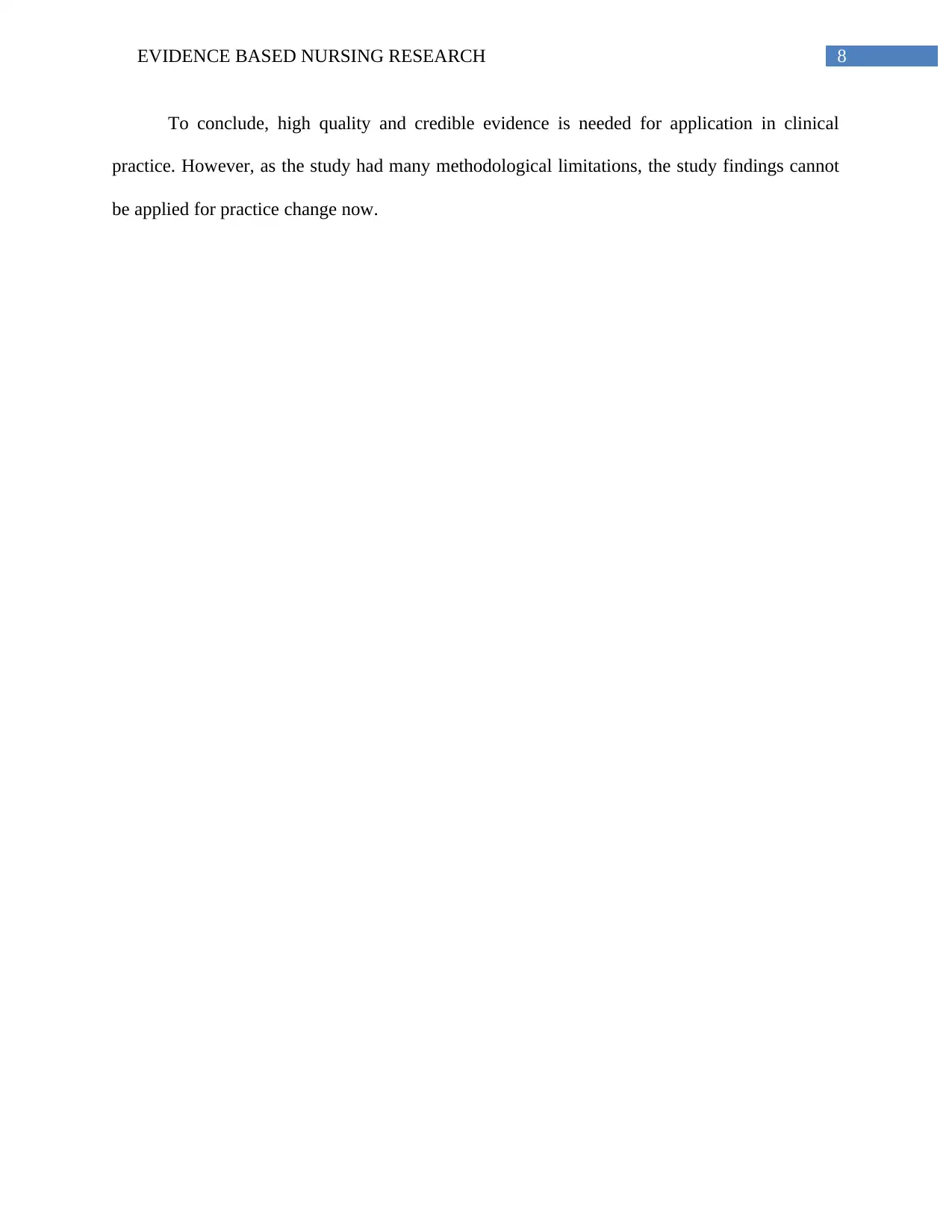
8EVIDENCE BASED NURSING RESEARCH
To conclude, high quality and credible evidence is needed for application in clinical
practice. However, as the study had many methodological limitations, the study findings cannot
be applied for practice change now.
To conclude, high quality and credible evidence is needed for application in clinical
practice. However, as the study had many methodological limitations, the study findings cannot
be applied for practice change now.
⊘ This is a preview!⊘
Do you want full access?
Subscribe today to unlock all pages.

Trusted by 1+ million students worldwide
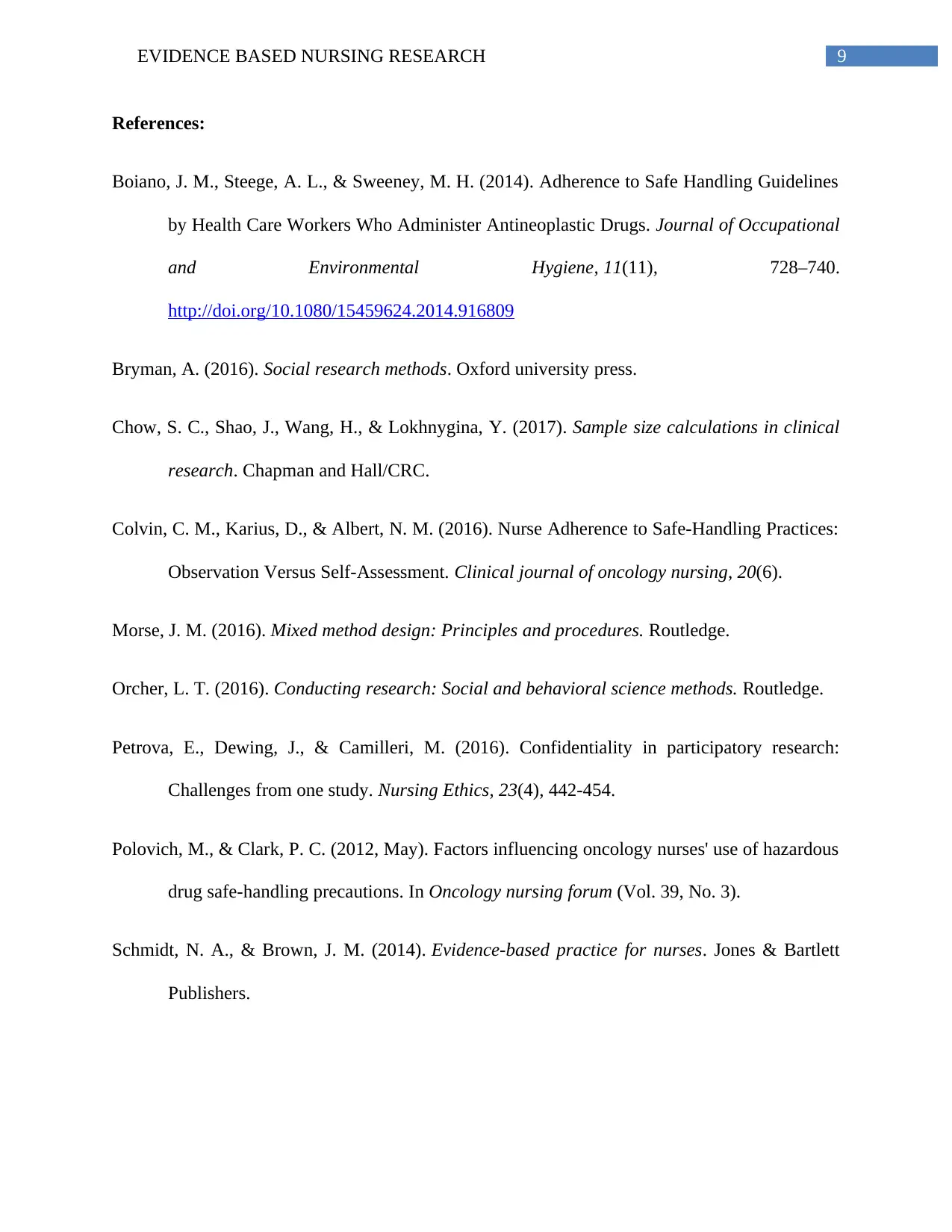
9EVIDENCE BASED NURSING RESEARCH
References:
Boiano, J. M., Steege, A. L., & Sweeney, M. H. (2014). Adherence to Safe Handling Guidelines
by Health Care Workers Who Administer Antineoplastic Drugs. Journal of Occupational
and Environmental Hygiene, 11(11), 728–740.
http://doi.org/10.1080/15459624.2014.916809
Bryman, A. (2016). Social research methods. Oxford university press.
Chow, S. C., Shao, J., Wang, H., & Lokhnygina, Y. (2017). Sample size calculations in clinical
research. Chapman and Hall/CRC.
Colvin, C. M., Karius, D., & Albert, N. M. (2016). Nurse Adherence to Safe-Handling Practices:
Observation Versus Self-Assessment. Clinical journal of oncology nursing, 20(6).
Morse, J. M. (2016). Mixed method design: Principles and procedures. Routledge.
Orcher, L. T. (2016). Conducting research: Social and behavioral science methods. Routledge.
Petrova, E., Dewing, J., & Camilleri, M. (2016). Confidentiality in participatory research:
Challenges from one study. Nursing Ethics, 23(4), 442-454.
Polovich, M., & Clark, P. C. (2012, May). Factors influencing oncology nurses' use of hazardous
drug safe-handling precautions. In Oncology nursing forum (Vol. 39, No. 3).
Schmidt, N. A., & Brown, J. M. (2014). Evidence-based practice for nurses. Jones & Bartlett
Publishers.
References:
Boiano, J. M., Steege, A. L., & Sweeney, M. H. (2014). Adherence to Safe Handling Guidelines
by Health Care Workers Who Administer Antineoplastic Drugs. Journal of Occupational
and Environmental Hygiene, 11(11), 728–740.
http://doi.org/10.1080/15459624.2014.916809
Bryman, A. (2016). Social research methods. Oxford university press.
Chow, S. C., Shao, J., Wang, H., & Lokhnygina, Y. (2017). Sample size calculations in clinical
research. Chapman and Hall/CRC.
Colvin, C. M., Karius, D., & Albert, N. M. (2016). Nurse Adherence to Safe-Handling Practices:
Observation Versus Self-Assessment. Clinical journal of oncology nursing, 20(6).
Morse, J. M. (2016). Mixed method design: Principles and procedures. Routledge.
Orcher, L. T. (2016). Conducting research: Social and behavioral science methods. Routledge.
Petrova, E., Dewing, J., & Camilleri, M. (2016). Confidentiality in participatory research:
Challenges from one study. Nursing Ethics, 23(4), 442-454.
Polovich, M., & Clark, P. C. (2012, May). Factors influencing oncology nurses' use of hazardous
drug safe-handling precautions. In Oncology nursing forum (Vol. 39, No. 3).
Schmidt, N. A., & Brown, J. M. (2014). Evidence-based practice for nurses. Jones & Bartlett
Publishers.
Paraphrase This Document
Need a fresh take? Get an instant paraphrase of this document with our AI Paraphraser
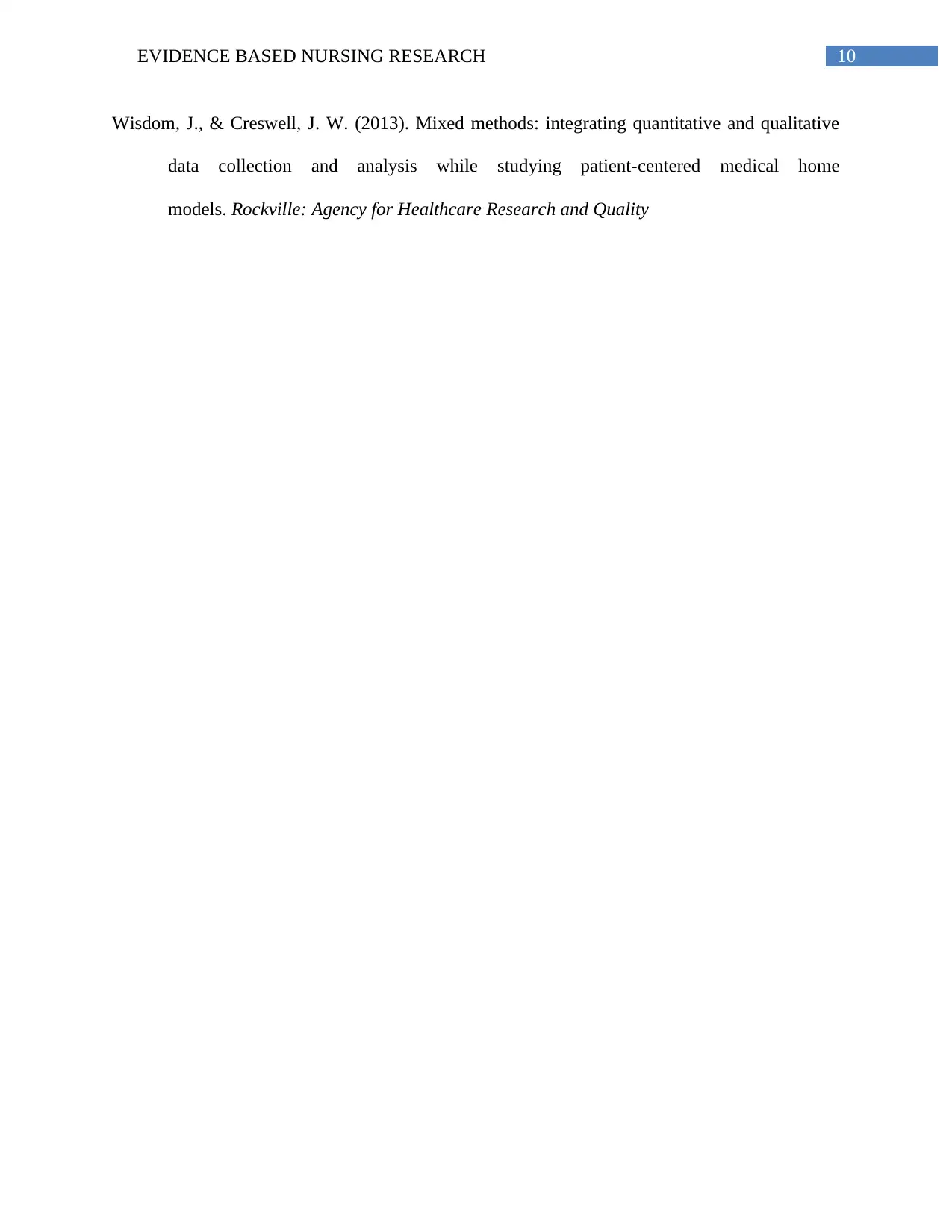
10EVIDENCE BASED NURSING RESEARCH
Wisdom, J., & Creswell, J. W. (2013). Mixed methods: integrating quantitative and qualitative
data collection and analysis while studying patient-centered medical home
models. Rockville: Agency for Healthcare Research and Quality
Wisdom, J., & Creswell, J. W. (2013). Mixed methods: integrating quantitative and qualitative
data collection and analysis while studying patient-centered medical home
models. Rockville: Agency for Healthcare Research and Quality
1 out of 11
Related Documents
Your All-in-One AI-Powered Toolkit for Academic Success.
+13062052269
info@desklib.com
Available 24*7 on WhatsApp / Email
![[object Object]](/_next/static/media/star-bottom.7253800d.svg)
Unlock your academic potential
Copyright © 2020–2025 A2Z Services. All Rights Reserved. Developed and managed by ZUCOL.


